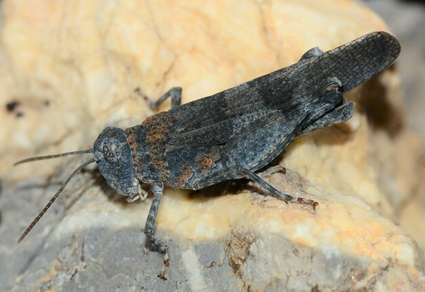Abstract
Hochkirch et al. (2023) recently published a phylogeny of the band-winged grasshopper genus Oedipoda. Using three mitochondrial and one nuclear loci, they estimated the phylogeny of 177 specimens. This phylogeny offers insights into the evolutionary history and biogeography of the group and demonstrates the usefulness of molecular data to estimated populations and species histories. They also provide valid taxonomical changes, raising two former subspecies and one former synonymy to the species level. However, we believe that taxonomic changes regarding synonymization proposed by the authors are premature given the data utilized. Indeed, we will illustrate cases below where well-established species lack support from mitochondrial data, which is comparable to or even more extensive than that used by Hochkirch et al. (2023).
References
- Defaut, B. (2022) Notes de lecture phylogénétique sur les Orthoptères. 4. L’étude de Nolen & al. (2020) sur la radiation des espèces européennes de « Chorthippus ». Matériaux orthoptériques et entomocénotiques, 27, 13–15.
- Defaut, B. (2006) Révision préliminaire des Oedipoda ouest-paléarctiques (Caelifera, Acrididae, Oedipodinae). Matériaux orthoptériques et entomocénotiques, 11, 23–48.
- Hawlitschek, O., Morinière, J., Lehmann, G.U.C., Lehmann, A.W., Kropf, M., Dunz, A., Glaw, F., Detcharoen, M., Schmidt, S., Hausmann, A., Szucsich, N.U., Caetano-Wyler, S.A. & Haszprunar, G. (2017) DNA barcoding of crickets, katydids and grasshoppers (Orthoptera) from Central Europe with focus on Austria, Germany and Switzerland. Molecular Ecology Resources, 17, 1037–1053. https://doi.org/10.1111/1755-0998.12638
- Hawlitschek, O., Ortiz, E.M., Noori, S., Webster, K.C., Husemann, M. & Pereira, R.J. (2022) Transcriptomic data reveals nuclear-mitochondrial discordance in Gomphocerinae grasshoppers (Insecta: Orthoptera: Acrididae). Molecular Phylogenetics and Evolution, 170, 107439. https://doi.org/10.1016/j.ympev.2022.107439
- Hertach, T., Puissant, S., Gogala, M., Trilar, T., Hagmann, R., Baur, H., Kunz, G., Wade, E.J., Loader, S.P. & Simon, C. (2016) Complex within a complex: Integrative taxonomy reveals hidden diversity in Cicadetta brevipennis (Hemiptera: Cicadidae) and unexpected relationships with a song divergent relative. PLoS One, 11, e0165562. https://doi.org/10.1371/journal.pone.0165562
- Hertach, T., Trilar, T., Wade, E.J., Simon, C. & Nagel, P. (2015) Songs, genetics, and morphology: revealing the taxonomic units in the European Cicadetta cerdaniensis cicada group, with a description of new taxa (Hemiptera: Cicadidae). Zoological Journal of the Linnean Society 173, 320–351. https://doi.org/10.1111/zoj.12212
- Hochkirch, A., Dey, L.-S. & Husemann, M. (2023) Phylogeography of the grasshopper genus Oedipoda (Acrididae: Oedipodinae) in the Mediterranean: classic refugia and cryptic lineages. Biological Journal of the Linnean Society, 140 (1), 85–95. https://doi.org/10.1093/biolinnean/blad044
- Hollier, J. (2012) An annotated list ot the Orthoptera (Insecta) species described by Henri de Saussure, with an account of the primary type material housed in the Muséum d’histoire naturelle de Genève, Part 2 : The Acrididae: Oedipodinae. Revue suisse de Zoologie, 119, 215–260.
- Khan, M., Joshi, M., Espeland, M., Huemer, P., Lopez-Vaamonde, C. & Mutanen, M. (2024) Patterns of speciation in a parapatric pair of Saturnia moths as revealed by target capture. Molecular Ecology, 33, e17194. https://doi.org/10.1111/mec.17194
- Mayr, E. (1963) Animal Species and Evolution. Harvard University Press, Cambridge, Massachusetts, 814 pp. https://doi.org/10.4159/harvard.9780674865327
- Minh, B.Q., Schmidt, H.A., Chernomor, O., Schrempf, D., Woodhams, M.D., von Haeseler, A. & Lanfear, R. (2020) IQ-TREE 2: New Models and Efficient Methods for Phylogenetic Inference in the Genomic Era. Molecular Biology and Evolution, 37, 1530–1534. https://doi.org/10.1093/molbev/msaa015
- Nabholz, B. (2023) Incomplete lineage sorting explains the low performance of DNA barcoding in a radiation of four species of Western European grasshoppers (Orthoptera: Acrididae: Chorthippus). Biological Journal of the Linnean Society, blad106. https://doi.org/10.1093/biolinnean/blad106
- Nattier, R., Robillard, T., Amedegnato, C., Couloux, A., Cruaud, C. & Desutter‐Grandcolas, L. (2011) Evolution of acoustic communication in the Gomphocerinae (Orthoptera: Caelifera: Acrididae). Zoologica Scripta, 40, 479–497. https://doi.org/10.1111/j.1463-6409.2011.00485.x
- Nikelski, E., Rubtsov, A.S. & Irwin, D. (2023) High heterogeneity in genomic differentiation between phenotypically divergent songbirds: a test of mitonuclear co-introgression. Heredity, 130, 1–13. https://doi.org/10.1038/s41437-022-00580-8
- Nolen, Z.J., Yildirim, B., Irisarri, I., Liu, S., Groot Crego, C., Amby, D.B., Mayer, F., Gilbert, M.T.P. & Pereira, R.J. (2020) Historical isolation facilitates species radiation by sexual selection: Insights from Chorthippus grasshoppers. Molecular Ecology, 29, 4985–5002. https://doi.org/10.1111/mec.15695
- Schmidt, R., Dufresnes, C., Krištín, A., Künzel, S., Vences, M. & Hawlitschek, O. (2024) Phylogenetic Insights into Central European Chorthippus and Pseudochorthippus (Orthoptera: Acrididae) Species Using ddRADseq Data. Molecular Phylogenetics and Evolution, 193, 108012. https://doi.org/10.1016/j.ympev.2024.108012
- Song, H., Buhay, J.E., Whiting, M.F. & Crandall, K.A. (2008) Many species in one: DNA barcoding overestimates the number of species when nuclear mitochondrial pseudogenes are coamplified. Proceedings of the national academy of sciences, 105, 13486–13491. https://doi.org/10.1073/pnas.0803076105
- Vedenina, V. & Mugue, N. (2011) Speciation in gomphocerine grasshoppers: molecular phylogeny versus bioacoustics and courtship behavior. Journal of Orthoptera Research, 20 (1), 109–125. https://doi.org/10.1665/034.020.0111


